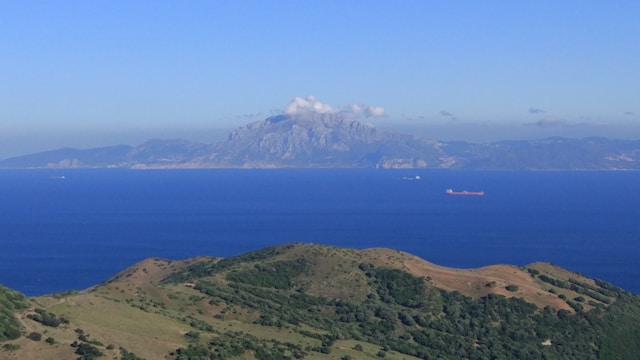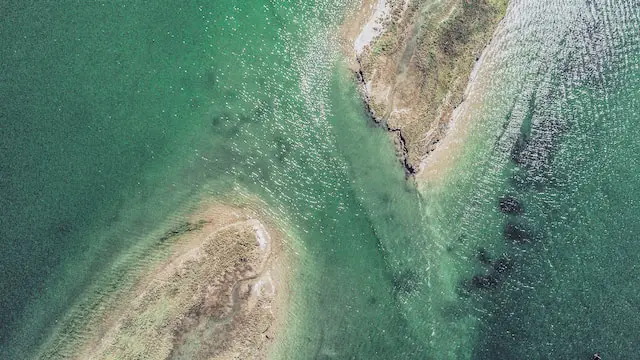An isthmus is a narrow strip of land that connects two larger landmasses, while a strait is a narrow channel of water that connects two larger bodies of water. The differences between these geographical features are important to understand not only for academic purposes but also for their significant impact on international trade routes. The Suez Canal, though often referred to as an isthmus or even a strait by some people due to its similar function in connecting the Red Sea to the Mediterranean Sea, is technically neither one.
The definition of an isthmus
(Photo by Zachary Ferguson on Unsplash )

An isthmus is a narrow strip of land that connects two larger landmasses and separates two bodies of water. It’s like a natural bridge between continents or islands, forming a link where there was none before. For example, the Isthmus of Panama connects North America to South America and separates the Atlantic Ocean from the Pacific Ocean.
Isthmuses are usually formed by geological processes such as tectonic movements, volcanic eruptions, or sediment deposition over millions of years. They can vary in size from just a few meters to several kilometers wide depending on their location and age.
One important characteristic of isthmuses is that they often serve as barriers to migration for animals and plants. This can lead to unique ecosystems with endemic species found only in certain areas.
Furthermore, many isthmuses have been crucial throughout history for transportation routes and trade flows since they offer shorter travel distances between different parts of the world. In fact, some countries rely heavily on their strategic positions at key isthmuses for their economic growth and prosperity.
The definition of a strait
(Photo by Alejandro Martin on Unsplash )

A strait is a narrow body of water that connects two larger bodies of water. It can be formed by natural or man-made means, and it plays an important role in maritime transportation. The word “strait” comes from the Old French estreit, meaning “narrow,” which accurately describes its physical characteristics.
Unlike an isthmus, which is a narrow strip of land connecting two larger land masses, a strait is entirely surrounded by water. This makes navigation through a strait more challenging than sailing along an open sea route because there are often strong currents and potential hazards such as rocks or shoals.
Straits can range in size from just a few meters wide to several hundred kilometers wide. Some famous examples include the Strait of Gibraltar, which connects the Mediterranean Sea to the Atlantic Ocean; the Bosphorus Strait, which divides Europe and Asia in Turkey; and the Malacca Strait, one of the busiest shipping lanes in Southeast Asia.
Because they serve as major trade routes between different regions or countries, many straits have become strategic locations for military bases and naval operations throughout history. However, this has also made them vulnerable to conflicts over territorial waters and shipping rights.
While both isthmuses and straits are narrow passages with unique geographic features that play important roles in global trade and transportation systems., their differences lie mainly on how they connect different parts of lands together – whether through landmasses (isthmus) or via seawater (strait).
Isthmus Vs. Strait – Key differences
When it comes to geographic features, isthmuses and straits are two terms that are often used interchangeably. However, there is a significant difference between the two.
An isthmus is a narrow strip of land connecting two larger land areas and located between two bodies of water. A classic example of an isthmus is the Isthmus of Panama which connects North America and South America. On the other hand, a strait refers to a narrow passage of water connecting two large bodies of water. The Strait of Gibraltar is one such example as it connects the Atlantic Ocean to the Mediterranean Sea.
The key difference between an isthmus and a strait lies in their shape. While an isthmus appears as a thin piece of land separating larger bodies on either side, a strait looks like an elongated canal that joins together different oceans or seas.
Another important distinction lies in their functionality for transportation purposes. An isthmus provides overland travel options while reducing voyage times around coastal regions. Meanwhile, Straits offer marine transport options by allowing boats or ships to pass through them from one body of water to another.
Both Isthmuses and Straits are essential geographical features that have been instrumental in shaping human history for thousands years; however they serve different purposes based on location, size & topography!
Examples of isthmuses?
An isthmus is a narrow strip of land that connects two larger pieces of land, with water on either side. The most famous example of an isthmus is the Isthmus of Panama in Central America, which separates North and South America.
Another notable example is the Isthmus of Corinth in Greece, which connects the Peloponnese peninsula to mainland Greece. It was significant in ancient times as it allowed ships to avoid sailing around the treacherous waters surrounding the southern coast.
The Kra Isthmus in Thailand is another important isthmus as it provides a vital connection between Southeast Asia and Malaysia. It has been proposed as a possible location for a canal linking the Indian Ocean with the Pacific Ocean.
In Mexico, there’s also an important isthmus called Istmo de Tehuantepec that connects Oaxaca state from north to south across 200km; its narrowest point measures only about 200 meters wide!
Isthmuses have played significant roles throughout history by providing strategic locations for trade routes or military movements. They continue to be relevant today due to their impact on transportation and communication networks worldwide.
Examples of straits?
There are numerous straits around the world, some of which are notable and significant for various reasons. The Strait of Gibraltar is one such example that separates Europe and Africa while connecting the Atlantic Ocean to the Mediterranean Sea. This narrow waterway has played a crucial role in international trade throughout history.
Another well-known strait is the Bosphorus Strait in Turkey, which connects Europe and Asia through Istanbul. It is an important passage for oil tankers carrying crude from Russia to European markets.
The Hormuz Strait located between Oman and Iran is also another famous strait that plays a vital role in global oil transportation as it connects the Persian Gulf with the Indian Ocean. Every day millions of barrels of oil pass through this narrow waterway making it one of the most strategic chokepoints on earth.
Other significant examples include Malacca Strait, Denmark Strait, Florida Straits, Tsugaru Strait among many others across different regions globally serving varied purposes ranging from defense security to tourism sites attracting visitors worldwide.
What is the role of isthmus and strait in international trade?
Isthmuses and straits play a crucial role in international trade. They provide important transportation routes for ships to pass through, allowing goods to be transported between different regions of the world.
For example, the Panama Canal is an isthmus that connects the Atlantic and Pacific Oceans, making it an essential route for shipping goods between East Asia and North America. Similarly, the Strait of Hormuz is a strategic passage point for oil tankers entering and exiting the Persian Gulf.
In addition to facilitating trade, isthmuses and straits also have significant geopolitical importance due to their potential as chokepoints. For instance, any disruptions or blockages in critical waterways like the Suez Canal can cause considerable global economic impact by interfering with maritime traffic flow.
Therefore, it’s clear that these geographic features are not just natural wonders but key players in shaping global commerce patterns; unlocking new opportunities while presenting risks that require careful navigation by governments and businesses alike.
Is the Suez Canal an Isthmus or Strait?
The Suez Canal is one of the most important shipping canals in the world, connecting the Mediterranean Sea and the Red Sea. But what exactly is it? Is it an isthmus or a strait?
Well, technically, neither! The Suez Canal is actually an artificial waterway that was constructed to connect two larger bodies of water. It was built in 1869 by Ferdinand de Lesseps and significantly reduced travel time between Europe and Asia.
Prior to its construction, ships had to sail all around Africa’s southern tip to get from one side of Eurasia to the other. This made trade much more difficult and expensive.
While not technically an isthmus or a strait, the Suez Canal plays a crucial role in international trade as a shortcut for maritime transportation. It allows ships carrying goods such as oil, natural gas, and other commodities to avoid traveling long distances around Africa.
In recent years, there has been some controversy over control of the canal due to its strategic importance. However, regardless of who controls it politically speaking – for now Egypt – this man-made marvel will continue serving as a vital link between East and West.
Where is the biggest isthmus?
The biggest isthmus in the world is located in Central America, between North and South America. It’s called the Isthmus of Panama and it measures approximately 50 miles wide at its narrowest point. The isthmus connects North and South America, allowing for a land bridge that has played an important role in both human migration and animal species distribution.
The construction of the Panama Canal made use of this geographical feature by cutting through the isthmus to create a shortcut for maritime trade between the Atlantic and Pacific Oceans. This engineering feat has allowed for faster transportation times and reduced shipping costs around the world.
Despite its small size compared to other continents, Central America boasts several significant landforms including towering mountains, active volcanoes, deep forests teeming with wildlife, extensive coastlines with white sandy beaches that stretch out into crystal clear waters filled with colorful reefs.
As such, the Isthmus of Panama plays a crucial role not only in international trade but also in biodiversity conservation as it serves as a vital corridor connecting two vast continents together.
Featured Image By – Jonathan Safa on Unsplash








